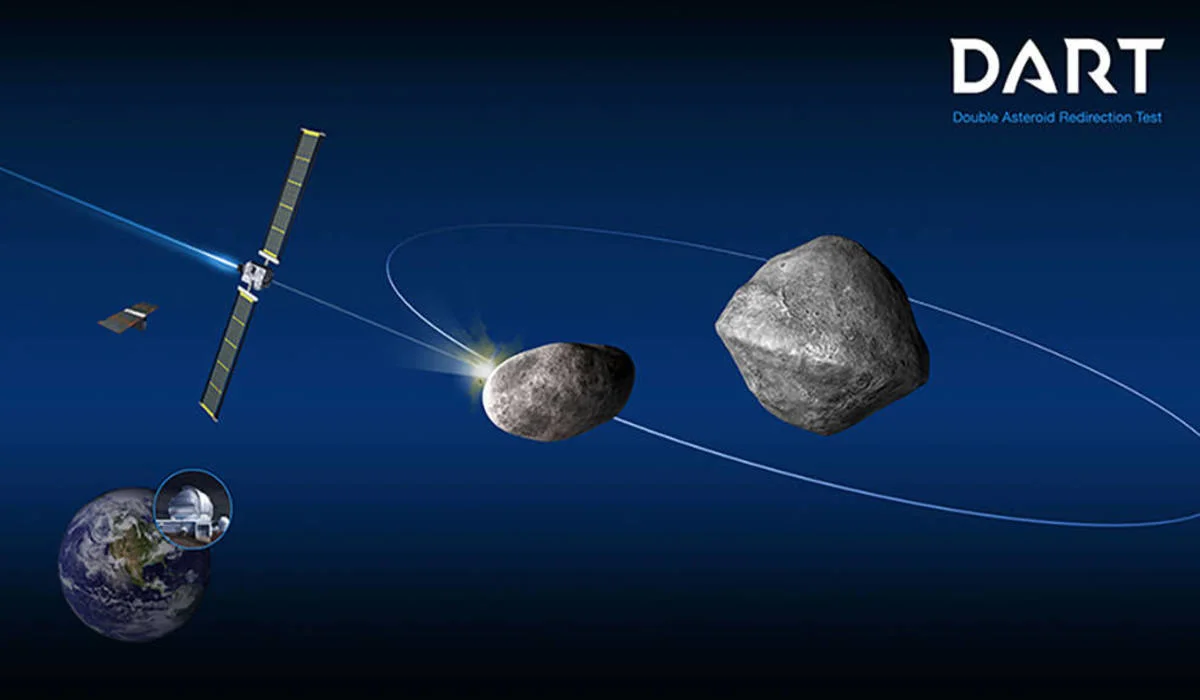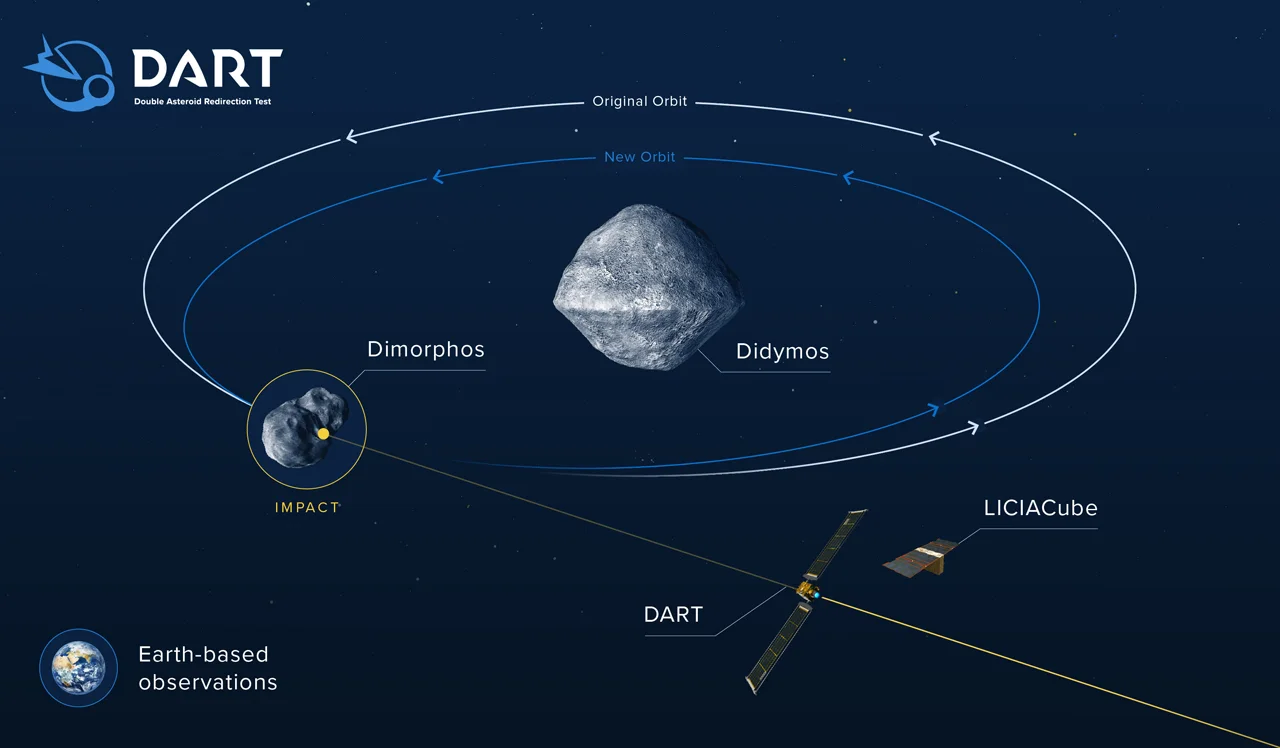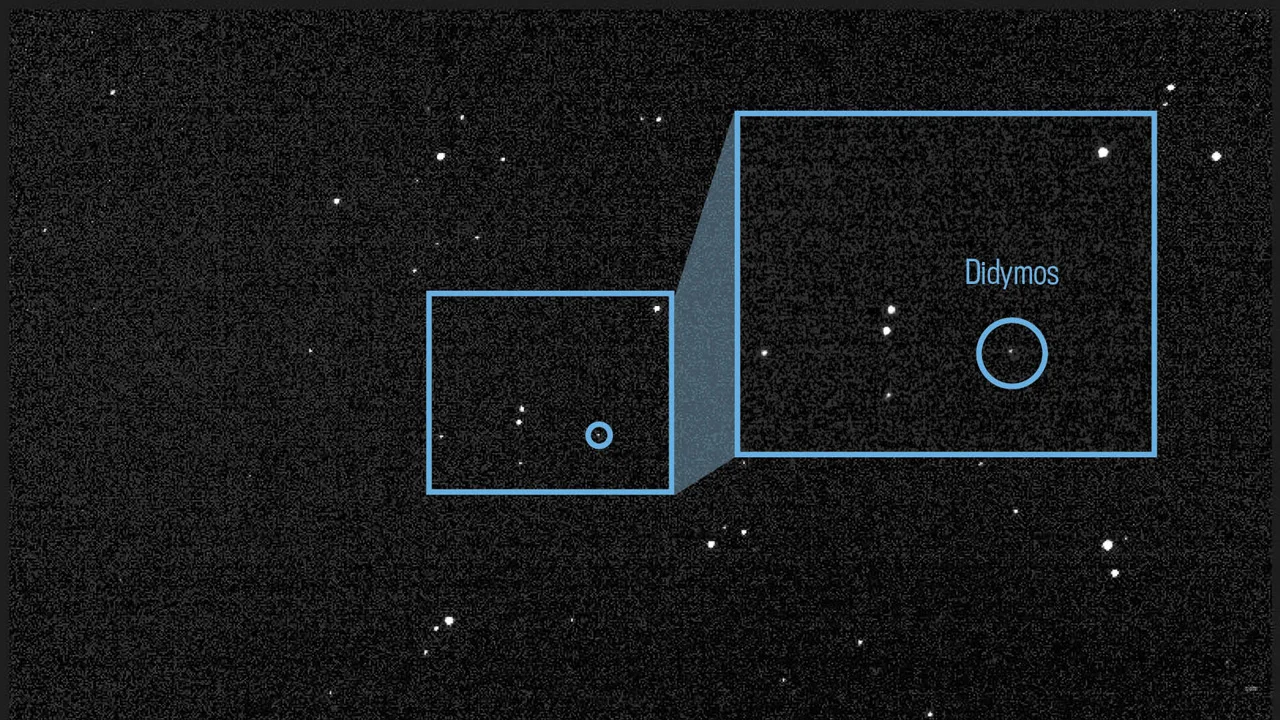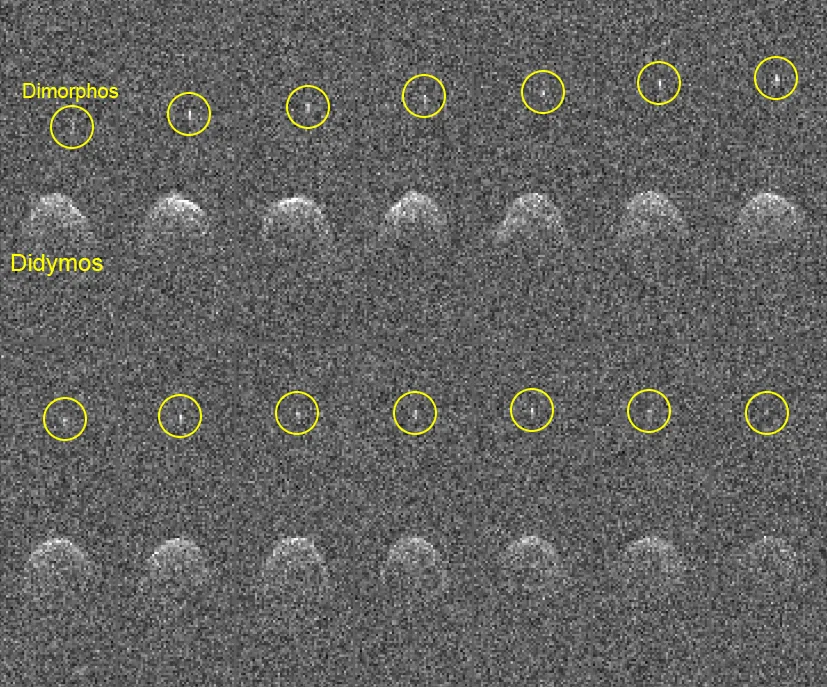
NASA's DART probe will slam into an asteroid today
What we learn from this intentional smash-up may one day save us from certain doom.
Today, a NASA probe will slam into a near-Earth asteroid. Scientists hope the mission will provide valuable insights that will help us defend ourselves against any asteroids that may pose a threat in the future.
NASA's Double-Asteroid Redirection Test mission, or DART, is now on final approach to its target. Squarely in the spacecraft's sights is Dimorphos, the 160-metre wide 'moon' of asteroid Didymos.
DART isn't like past asteroid missions, like Hayabusa 2 and OSIRIS-REx. The spacecraft isn't going to Didymos and Dimorphos to image and study them. Instead, when it arrives at the double-asteroid system on September 26, it will not so much as pause before it charges in, automatically homes in on Dimorphos, and slams into the small asteroid at top speed.

This artist's conception drawing shows DART's path to impact with asteroid Dimorphos, while telescopes on Earth watch from a safe distance. Credit: NASA/Johns Hopkins APL
According to NASA, the impact is expected at precisely 7:14 p.m. EDT.
DART is a test of the principles behind the 'Kinetic Impactor' method of asteroid deflection.
The mission's goal is for DART to hit Dimorphos as hard as possible, travelling at around 24,000 kilometres per hour. The hope is that impact will be enough to change the smaller asteroid's orbit around Didymos. Currently, Dimorphos takes around 12 hours to orbit Didymos. The impact could shorten that by up to 10 minutes.

The above infographic shows the current orbit of Dimorphos around Didymos, and its projected orbit following the impact of DART. Credit: NASA/Johns Hopkins APL
Didymos and Dimorphos will be around 11 million kilometres away (or 6.8 million miles) at the time of impact. That's a little over 28 times the distance to the Moon.
Observing from Earth via telescopes, though, scientists with the mission will be watching for any change in the timing of Dimorphos' orbit. They'll be able to see this by watching the brightness of the pair, as the total amount of light they emit diminishes every time Dimorphos passes in front or behind Didymos.
With that change in timing, along with knowing the mass of DART and its speed when it hit, they will be able to tell how successful they were in deflecting the asteroid. From there, ultimately, this should give them an idea if this method can be repeated with an asteroid that poses a threat to us, to deflect it away from Earth.

This image of the light from asteroid Didymos and its orbiting moonlet Dimorphos is a composite of 243 images taken by the Didymos Reconnaissance and Asteroid Camera for Optical navigation (DRACO) on July 27, 2022. Credits: NASA JPL DART Navigation Team
Given how close Didymos and Dimorphos are during this pass, there is the potential that debris from DART's impact could be ejected from the pair and end up in near-Earth space.
This possibility is of great interest to Paul Wiegert, an asteroid expert at Western University's Institute for Earth and Space Exploration (Western Space). Wiegert is an expert in the dynamics of the Solar System, particularly its smaller bodies like asteroids, comets and meteoroid streams.
"I suspect the amount of DART-ejected material that will reach the Earth is very small," Wiegert said in a Western Space press release.
"This is good news of course in many practical ways. The James Webb space telescope has already been hit by meteoroids and we're very happy that the DART impact won't contribute to that hazard."
--
RELATED: Webb's primary mirror was just hit by a meteoroid, but it was built to endure
--
The Didymos System
Didymos and Dimorphos are a binary asteroid — two asteroids bound together by gravity, with one orbiting the other.
Initially spotted in 1996 and simply named "1996 GT" to start, this pair was thought to be a single, unremarkable asteroid at the time. It wasn't until late 2003, when they made a reasonably close approach to Earth (around 7 million km or about 18x the distance to the Moon), that astronomers discovered the smaller companion asteroid.

The Didymos system, as imaged by radar from the Arecibo Observatory in Puerto Rico during its 2003 flyby of Earth. Credit: Arecibo Observatory/NASA
By bouncing radio waves from the Arecibo Observatory off the pair during its flyby, the primary asteroid was confirmed to be around 800 metres wide.
The binary companion was estimated to be about 170 metres wide, orbiting once every 12 hours or so.
The pair were named Didymos, which is Greek for "twin". The smaller of the pair was nicknamed Didymos B or "Didymoon" until it was given the official name of Dimorphos (Greek for "having two forms").
Isn't this dangerous??
It's important to note that Didymos and Dimorphos are not a threat to Earth — neither now nor at any point in the future. They do not even appear on NASA's Sentry Table of Impact Risk, which lists every known asteroid that has even the most remote chance of striking our planet within the next 1,000 years.
Also, this impact test will not have any effect on their impact risk for the future.
The orbit of Didymos and Dimorphos is well known. The closest it ever comes to Earth is on November 4, 2132, when it will be around 5.8 million kilometres away. Even then, that's more than 15 times farther away than the Moon. On September 26, 2022, the pair will be nearly twice that distance from Earth — around 11 million km away, or 28.6 times the distance to the Moon.
As a target for a kinetic impactor test, Dimorphos was the perfect option for NASA.
The pair pass within about 10 million km of Earth every 19 years or so. So, as long as they time the launch right, they can fly a spacecraft there in a reasonable amount of time.
Additionally, Dimorphos' orbit around Didymos is much slower than Didymos' orbit (or the orbit of other asteroids) around the Sun. Therefore, it's easier to deflect than a single asteroid, and it's easier for telescopes to detect the changes caused by the impact.

DART, Didymos, and Dimorphos are presented alongside various objects and structures to show their relative sizes. Credit: NASA/Johns Hopkins Advanced Physics Lab
Finally, this binary pair was a much less risky option than other targets. Science fiction has presented us with many nightmare scenarios stemming from the unintended consequences of science and space missions. However, regardless of the test's outcome, Dimorphos will continue to circle around Didymos. Also, both will continue their path around the Sun without changing their relative risk to Earth.
"We have not yet found any significant asteroid impact threat to Earth, but we continue to search for that sizable population we know is still to be found," Lindley Johnson, planetary defence officer at NASA Headquarters, said in a NASA press release. "Our goal is to find any possible impact, years to decades in advance, so it can be deflected with a capability like DART that is possible with the technology we currently ave."
"DART is one aspect of NASA's work to prepare Earth should we ever be faced with an asteroid hazard," Johnson added. "In tandem with this test, we are preparing the Near-Earth Object Surveyor Mission, a space-based infrared telescope scheduled for launch later this decade and designed to expedite our ability to discover and characterize the potentially hazardous asteroids and comets that come within 30 million miles [48 million km] of Earth's orbit."











